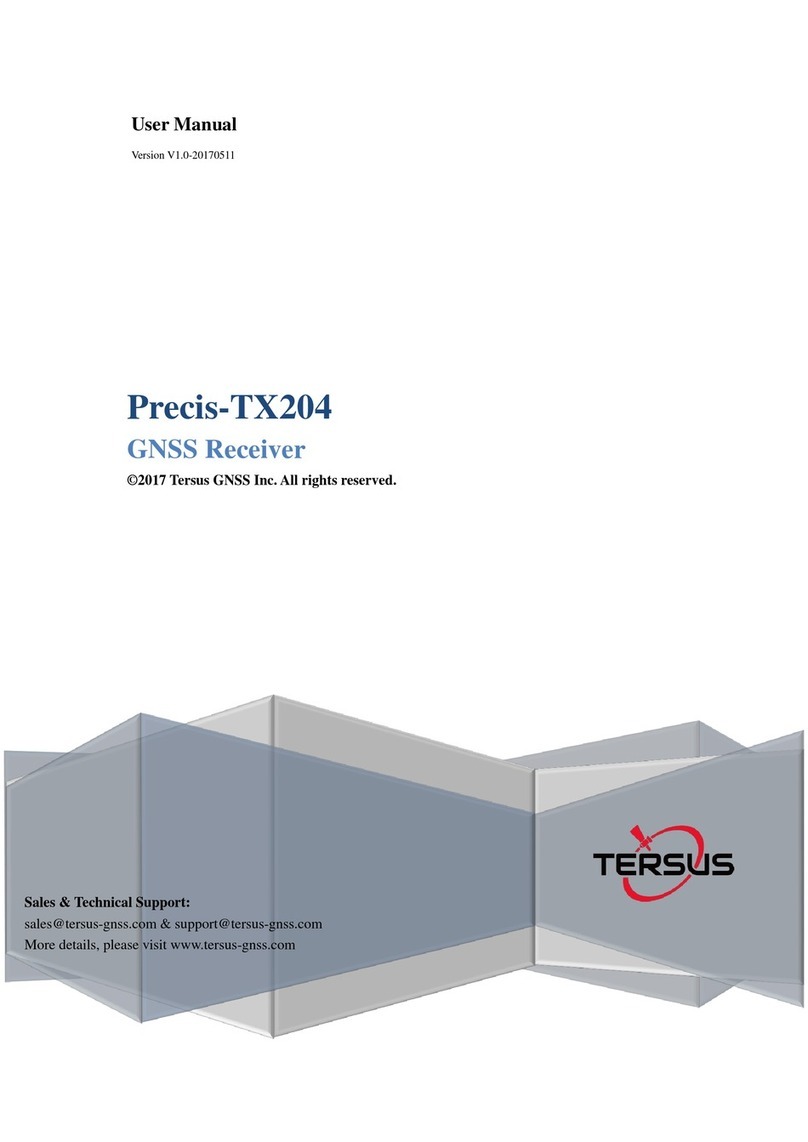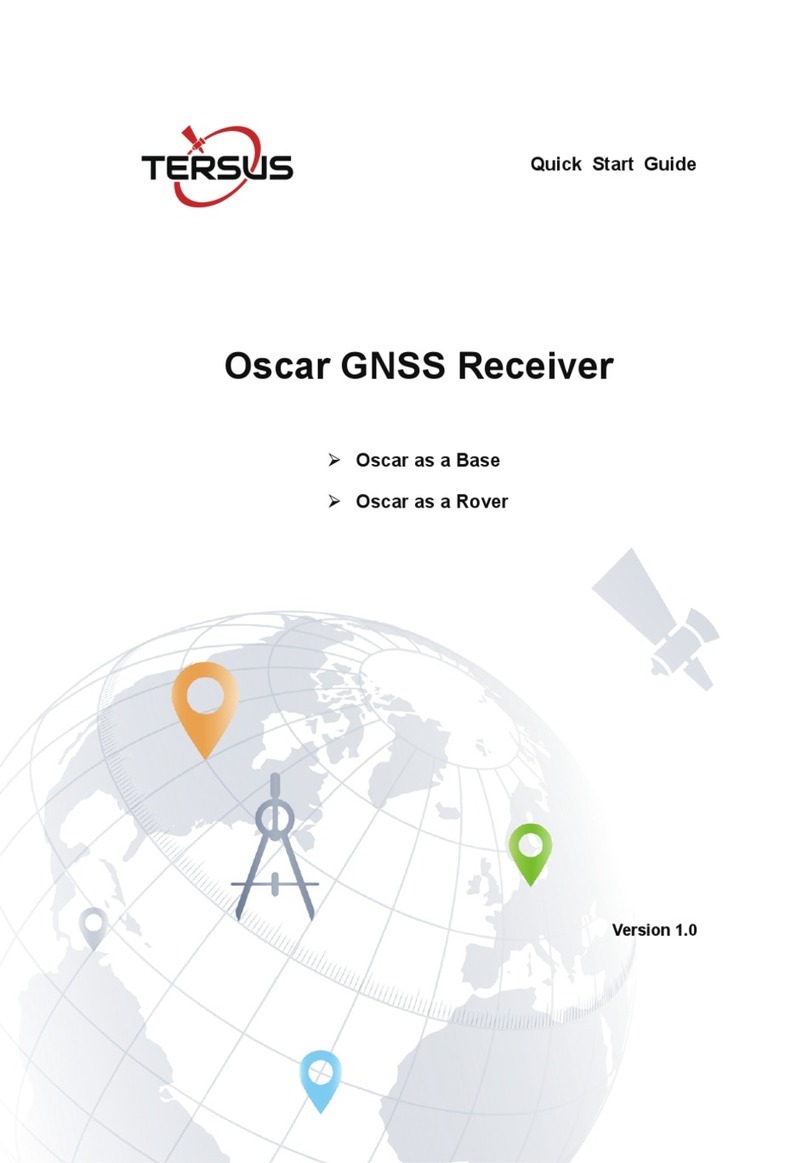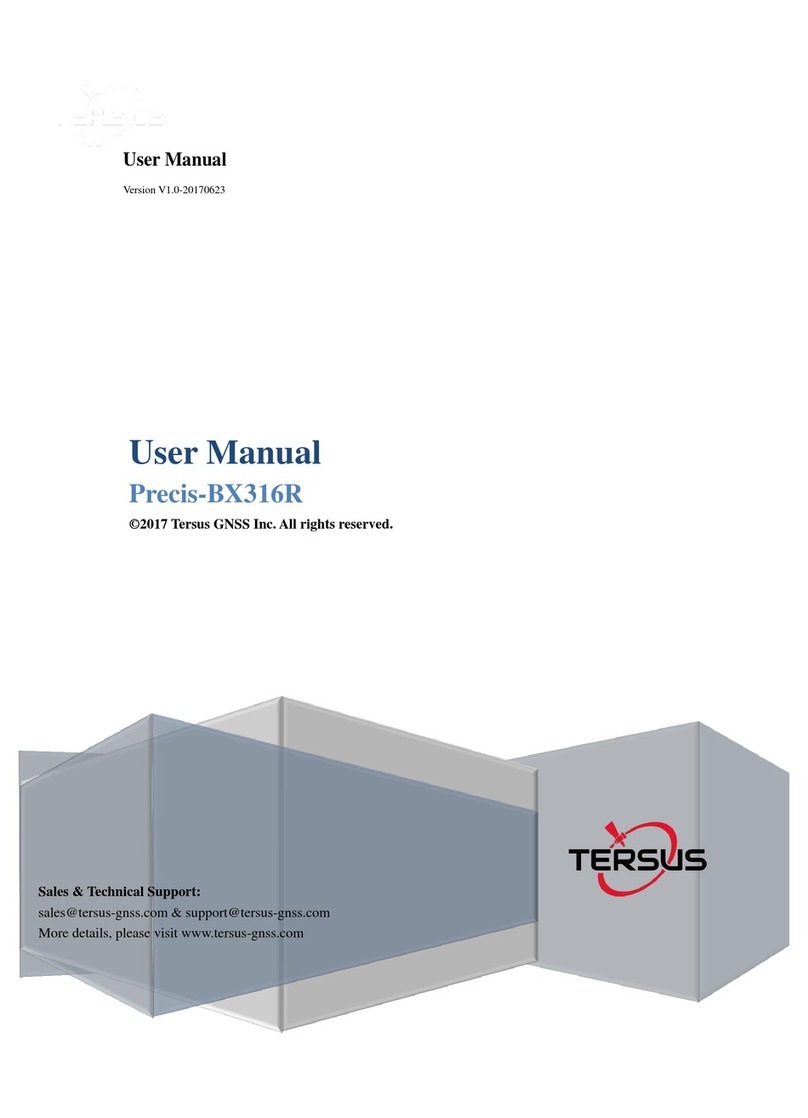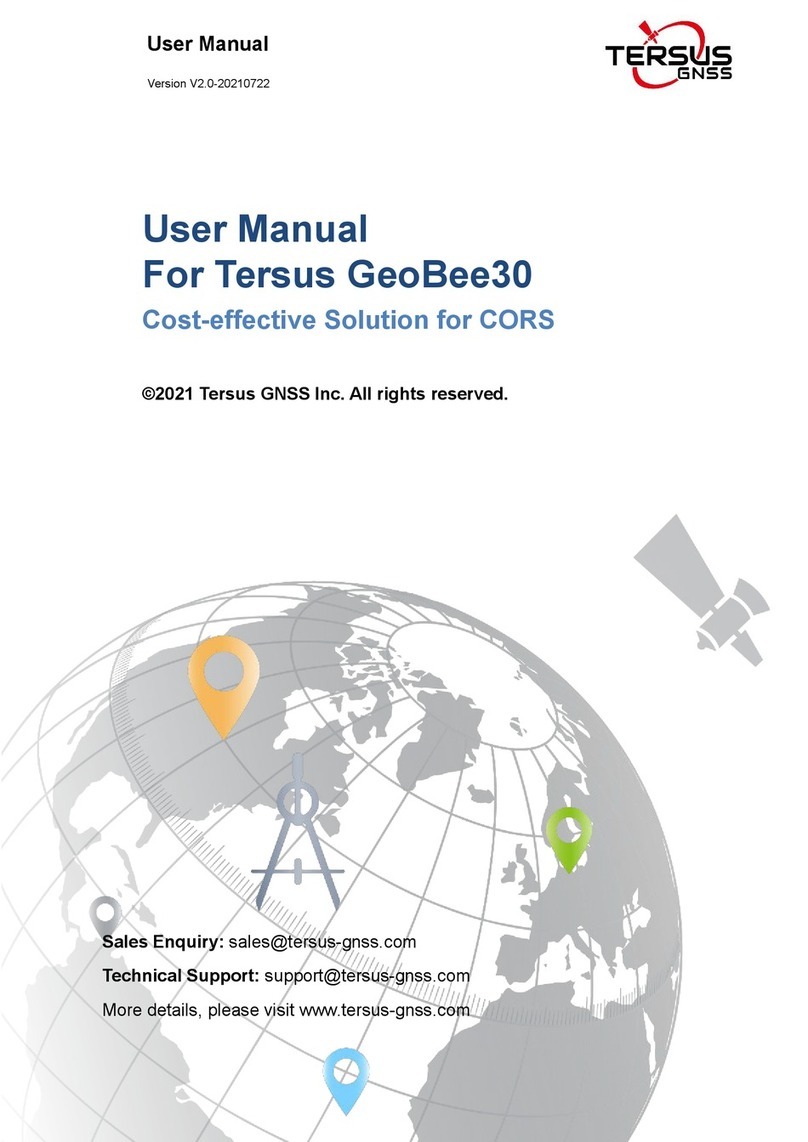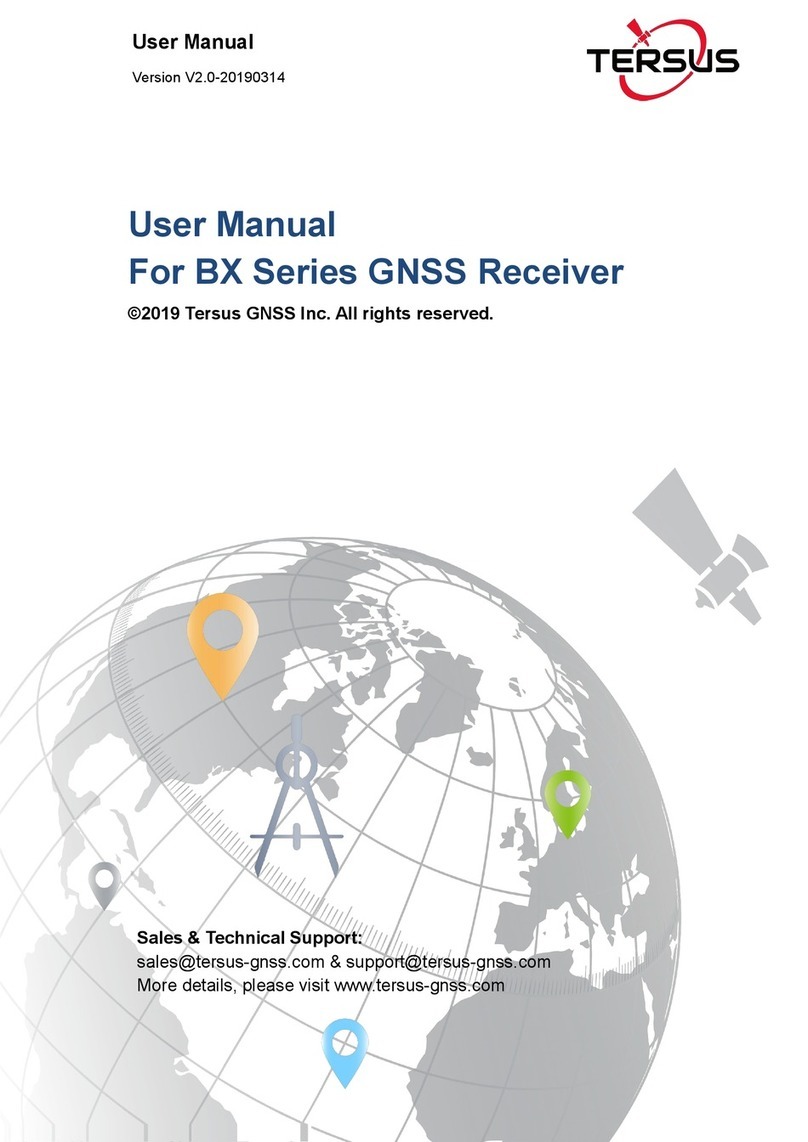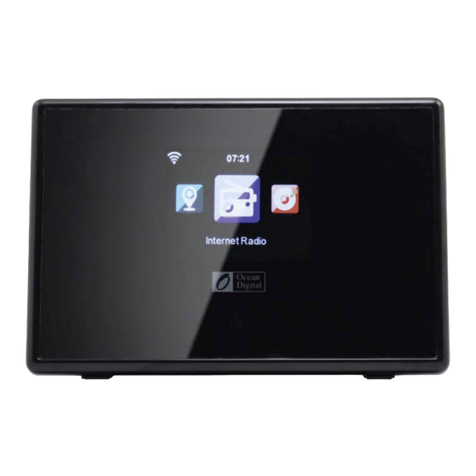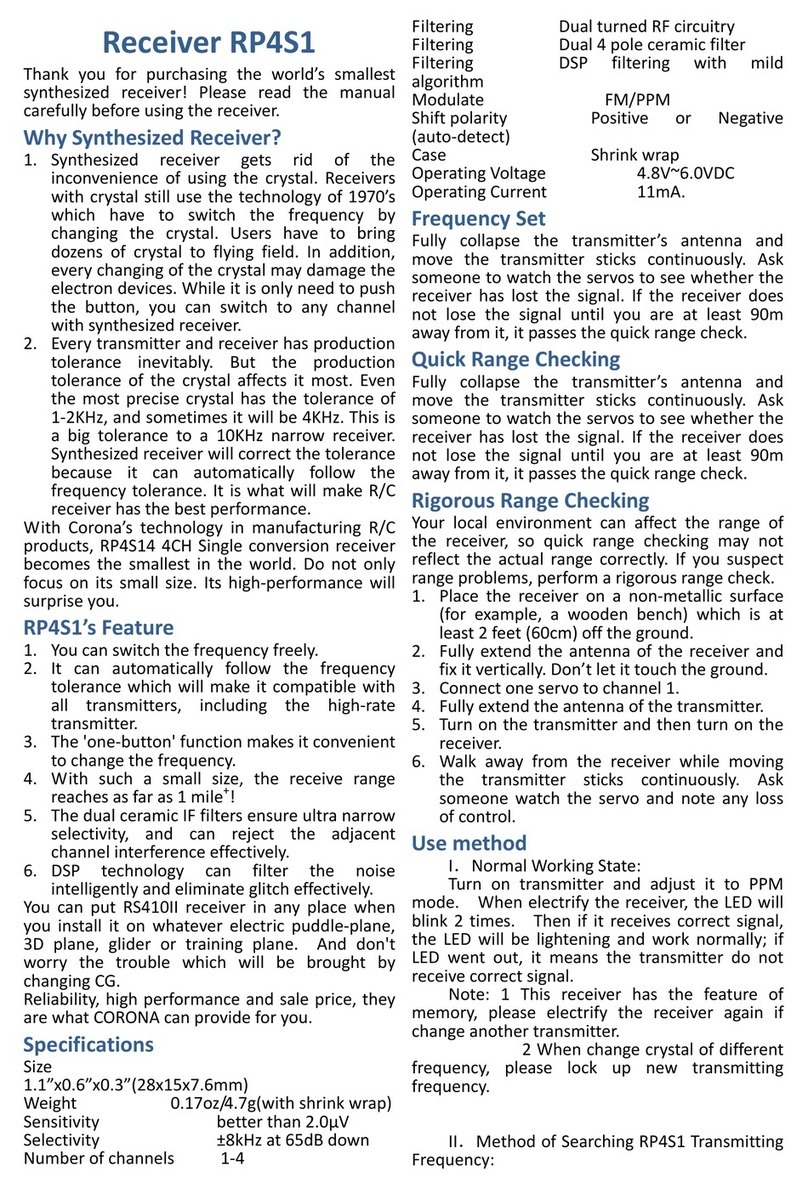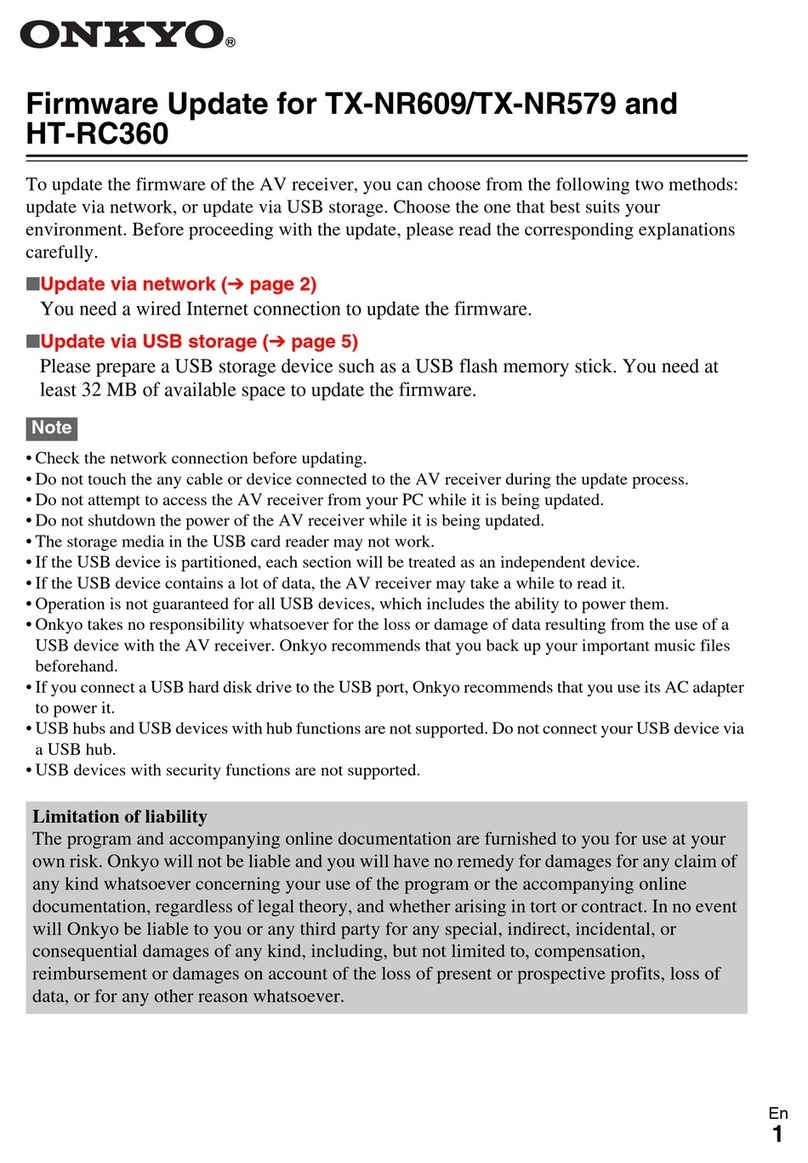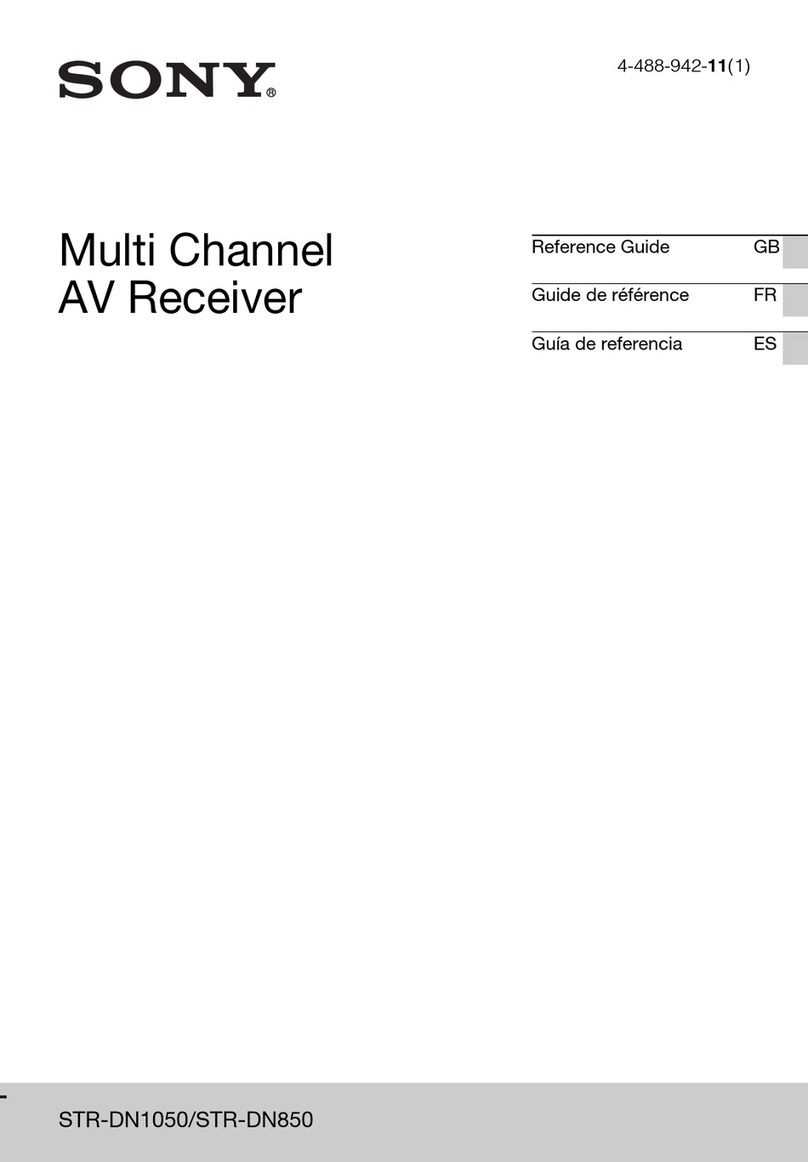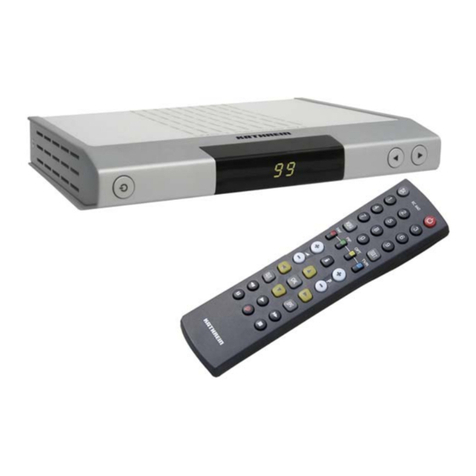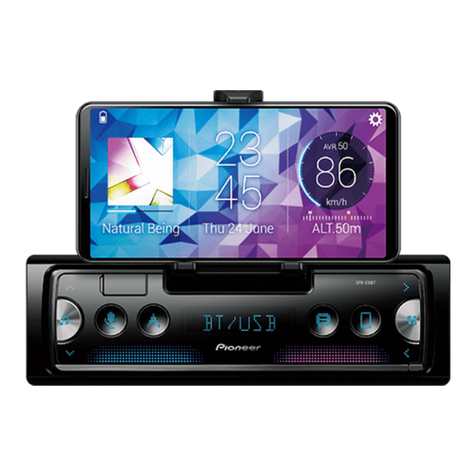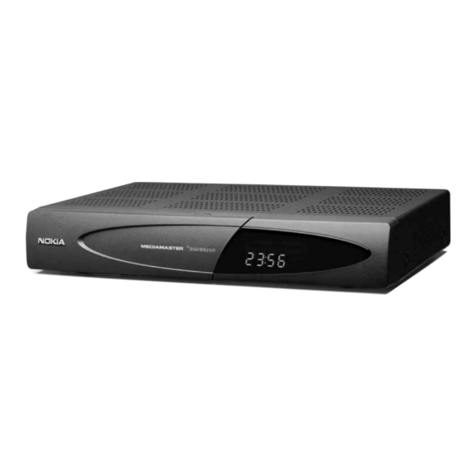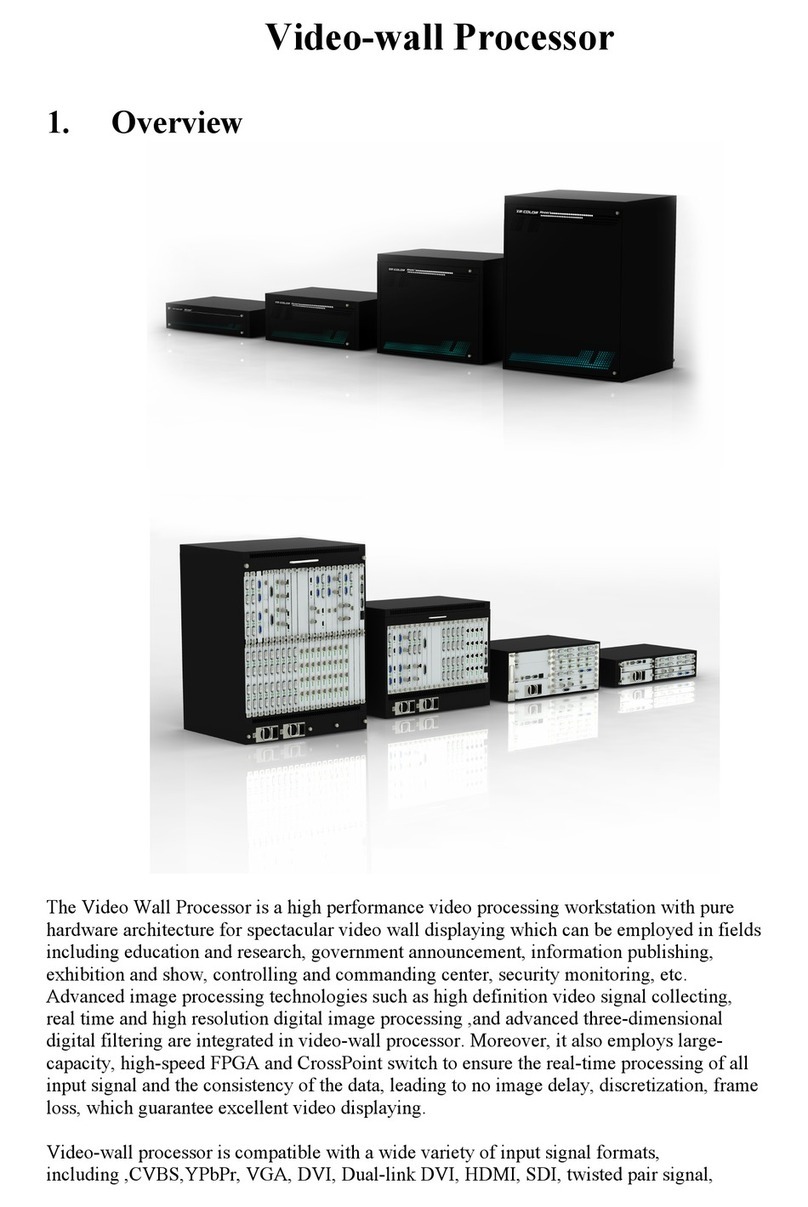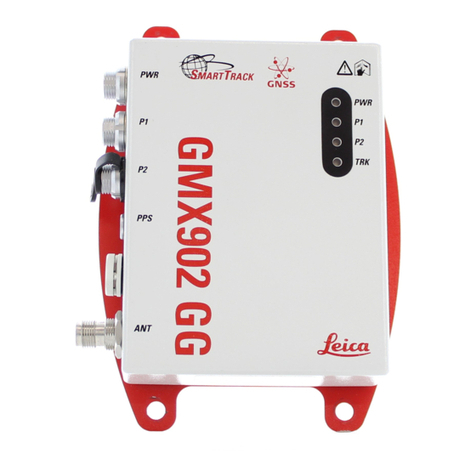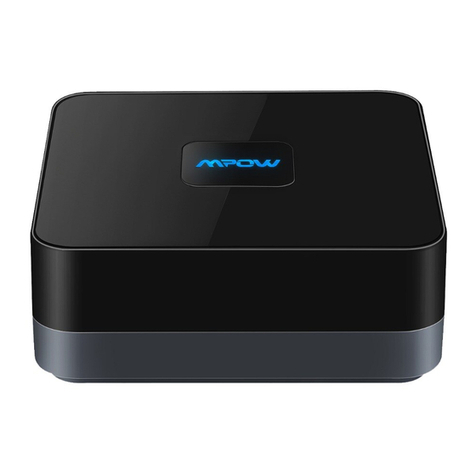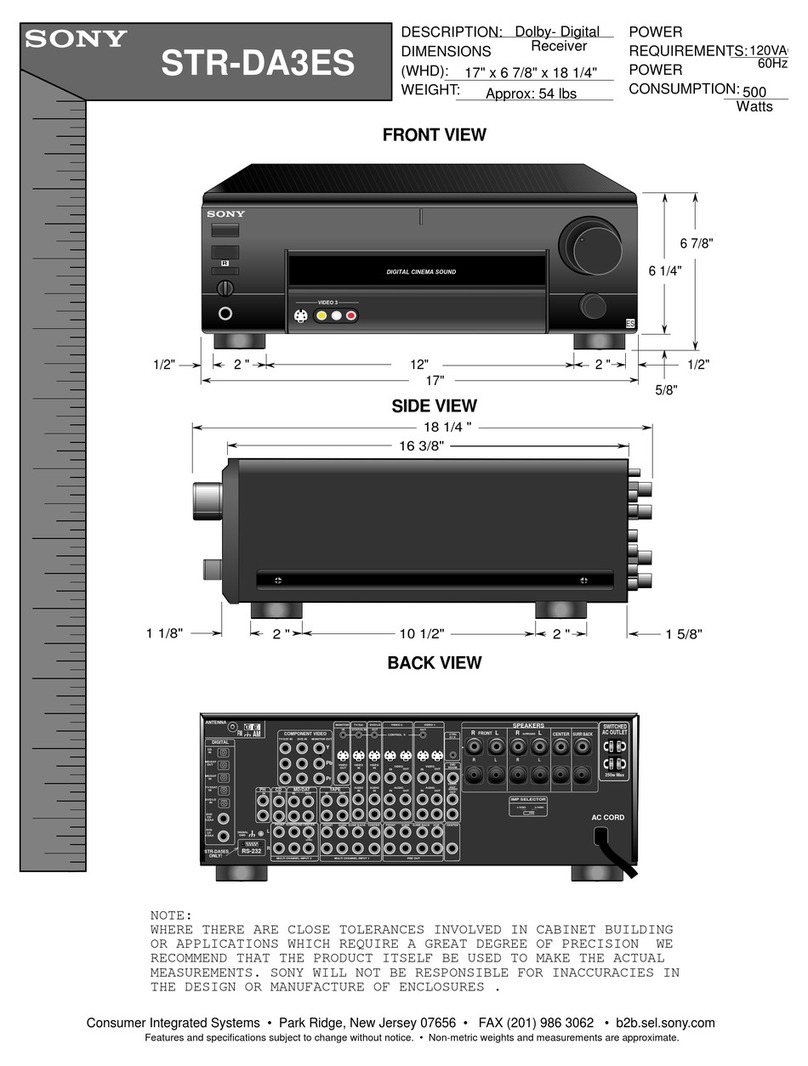TERSUS David30 User manual

Sales Enquiry: sales@tersus-gnss.com
Technical Support: support@tersus-gnss.com
More details, please visit www.tersus-gnss.com
User Manual
For David30 GNSS Receiver
©2021 Tersus GNSS Inc. All rights reserved.
User Manual
Version V2.0-20210721

User Manual for David30 GNSS Receiver v2.0
1
Revision History
Version
Revision Date
Change summary
1.0
20210427
Initial Release
2.0
20210721
Add CE&FCC marks and section7; upgrade the information
of 2W radio RS460H and 28w radio RS400H3.

User Manual for David30 GNSS Receiver v2.0
2
Table of Content
Revision History....................................................................................................................... 1
Table of Content.......................................................................................................................2
List of Figures........................................................................................................................... 5
List of Tables.............................................................................................................................8
Notices....................................................................................................................................... 9
1. Overview.............................................................................................................................12
1.1 Introduction...................................................................................................................12
1.2 Receiver Features.......................................................................................................13
1.3 Brief Introduction of GNSS and RTK....................................................................... 13
2. Devices in David30 Package...........................................................................................16
2.1 Rover Kit Network Mode............................................................................................ 17
2.1.1 David30 GNSS Receiver.................................................................................... 18
2.1.2 AX4E02 GNSS Antenna.....................................................................................19
2.1.3 DC-5pin power cable...........................................................................................20
2.1.4 COMM1-Bluetooth Module.................................................................................21
2.1.5 COMM2-7pin to USB & DB9 Cable.................................................................. 21
2.1.6 DB9 Male to USB Type A Male converter cable.............................................22
2.1.7 USB Type A Female to USB (Micro +Type C) OTG cable...........................23
2.1.8 Height Measure Accessory................................................................................ 23
2.1.9 Other accessories................................................................................................23
2.2 Rover Kit with 2W Radio Station...............................................................................26
2.2.1 2W Radio RS460H.............................................................................................. 27
2.2.2 410-470MHz Radio Whip Antenna................................................................... 28
2.2.3 COMM2-7pin to USB & 2W-Radio-5pin Cable............................................... 28
2.2.4 TNC-J to TNC-J Cable 1.0m (Radio Antenna Extension Cable)................. 29

User Manual for David30 GNSS Receiver v2.0
3
2.2.5 Bracket for 2W radio antenna with TNC-TNC converter............................... 30
2.3 Base Kit Network Mode..............................................................................................30
2.3.1 Bracket for Base...................................................................................................30
2.3.2 Tape Measure...................................................................................................... 31
2.3.3 Other accessories................................................................................................31
2.4 Base Kit with 2W Radio Station................................................................................ 32
2.4.1 DC-5pin Power cable.......................................................................................... 34
2.4.2 DC JACK male..................................................................................................... 34
2.4.3 High Gain Radio Antenna...................................................................................34
2.4.4 Metal plate for radio antenna............................................................................. 35
2.4.5 Telescopic pole for radio antenna.....................................................................35
2.4.6 Hook and Screws for 2W Radio........................................................................ 36
2.4.7 Hook and Screws for David30........................................................................... 36
2.4.8 Bracket for Mobile................................................................................................36
2.4.9 Other accessories................................................................................................37
2.5 Base Kit with 28W Radio RS400H3.........................................................................37
2.5.1 28W Radio RS400H3..........................................................................................38
2.5.2 28W-Radio power cable..................................................................................... 39
3. General operation..............................................................................................................40
3.1 Install the GNSS antenna.......................................................................................... 40
3.2 Power on David30.......................................................................................................41
3.3 Communication between Android device and David30........................................ 42
3.4 Firmware Update.........................................................................................................44
3.4.1 Hardware Connection......................................................................................... 44
3.4.2 USB to Serial COMM Port driver.......................................................................44
3.4.3 Firmware Update................................................................................................. 46
3.5 Auth Code.....................................................................................................................51
3.6 Download Files from Internal eMMC........................................................................52
3.7 Input command directly to the GNSS board........................................................... 53
4. Introduction of Nuwa.........................................................................................................55

User Manual for David30 GNSS Receiver v2.0
4
5. Specification....................................................................................................................... 58
5.1 David30 Receiver........................................................................................................58
5.2 Antenna AX4E02.........................................................................................................61
5.3 2W Radio RS460H......................................................................................................62
5.4 28W Radio RS400H3................................................................................................. 64
6. Typical operation............................................................................................................... 67
6.1 David30 as a Rover to receive corrections from Internet..................................... 68
6.2 David30 as a Base to transmit corrections to Internet.......................................... 72
6.3 Radios Transmit RTK Corrections between Two David30...................................77
6.4 Data Collection for Post Processing........................................................................ 81
6.5 Auto Base Station List Function................................................................................85
6.6 2W Radio operation.................................................................................................... 87
6.6.1 Radio Function Description................................................................................ 87
6.6.2 Radio Installation................................................................................................. 88
6.6.3 Antenna Installation.............................................................................................89
6.7 28W Radio operation..................................................................................................90
6.7.1 Radio basic operation......................................................................................... 90
6.7.2 Radio Installation................................................................................................. 96
6.7.3 Antenna Installation.............................................................................................97
7. Lightning-Proof Design.....................................................................................................98
7.1 Direct lightning protection.......................................................................................... 98
7.2 Inductive lightning protection.....................................................................................99
7.2.1Power lightning protection................................................................................... 99
7.2.2Lightning protection for communication cables................................................99
7.2.3Grounding net......................................................................................................100
8. Terminology..................................................................................................................... 101

User Manual for David30 GNSS Receiver v2.0
5
List of Figures
Figure 1.1 Outlook of David30 GNSS receiver..........................................12
Figure 1.2 Outline of David30 System........................................................ 14
Figure 1.3 Corrections transmitted via Internet ....................................... 14
Figure 1.4 Corrections transmitted with radios ........................................15
Figure 2.1 Devices in the box.......................................................................16
Figure 2.2 COMM1-Bluetooth Module........................................................ 21
Figure 2.3 COMM2-7pin to USB & DB9 Cable..........................................22
Figure 2.4 DB9 Male to USB Type A Male converter cable.....................22
Figure 2.5 USB Type A Female to USB (Micro + Type C) OTG cable .23
Figure 2.6 Height Measure Accessory........................................................23
Figure 2.7 Bracket for Rover ...................................................................... 24
Figure 2.8 Magic Tape ................................................................................. 24
Figure 2.9 Ranging Pole............................................................................... 24
Figure 2.10 Carrying Case for Rover ........................................................ 25
Figure 3.3 Outline of Android device to David30 with Bluetooth............ 42
Figure 3.4 Connect using Bluetooth............................................................43
Figure 3.5 Search Bluetooth device............................................................ 43
Figure 3.6 Outline of David30 connected to a Computer.........................44
Figure 3.7 COM port is recognized by the computer in the Computer
Management ............................................................................................ 45
Figure 3.8 Update Driver Software manually ...........................................46
Figure 3.9 Two methods of searching for driver software ......................46
Figure 3.10 PC software icons on desktop................................................ 47
Figure 3.11 Firmware Settings in TersusUpdate software....................... 48
Figure 3.12 Update Progress of the firmware update.............................. 48
Figure 3.13 Firmware update successful interface................................... 49
Figure 3.14 Advance Setting for firmware update ...................................50

User Manual for David30 GNSS Receiver v2.0
6
Figure 3.15 Register via Tersus GNSS Center..........................................51
Figure 3.16 Device Information interface on Nuwa app...........................52
Figure 3.17 Download file from eMMC....................................................... 53
Figure 3.18 Folders in the GNSS_U disk................................................... 53
Figure 4.1 Booting up page of Nuwa app...................................................55
Figure 4.2 Nuwa app interface 1 – Project.................................................56
Figure 4.3 Nuwa app interface 2 – Device................................................. 56
Figure 4.4 Nuwa app interface 3 – Survey.................................................57
Figure 4.5 Nuwa app interface 4 – Tools.................................................... 57
Figure 5.1 Panel of David30 ....................................................................... 60
Figure 5.2 Pin Definition of the COMM1/COMM2/DC ports ..................60
Figure 6.1 Outline of Android device to David30 with Wire – Rover .... 68
Figure 6.2 Connect David30 via USB......................................................... 69
Figure 6.3 Rover setting interface............................................................... 70
Figure 6.4 Edit Rover configuration.............................................................70
Figure 6.5 Rover is receiving RTK corrections.......................................... 71
Figure 6.6 Outline of Android device to David30 with Wire – Base ..... 72
Figure 6.7 Connect David30 via USB......................................................... 74
Figure 6.8 Base setting interface................................................................. 74
Figure 6.9 Edit Base configuration.............................................................. 74
Figure 6.10 Base is transmitting corrections..............................................75
Figure 6.11 Outline of Base/Rover with Radios.........................................77
Figure 6.12 Base work mode list................................................................. 79
Figure 6.13 Edit base configuration.............................................................79
Figure 6.14 Rover work mode list................................................................ 80
Figure 6.15 Edit rover configuration............................................................ 81
Figure 6.16 Outline of Static Data Collection.............................................82
Figure 6.17 Survey interface on Nuwa app................................................83
Figure 6.18 Static survey configuration...................................................... 83

User Manual for David30 GNSS Receiver v2.0
7
Figure 6.19 Auto Base Station List interface..............................................85
Figure 6.20 Fixed position for base station................................................ 86
Figure 6.21 Front Panel of the 2W Radio...................................................87
Figure 6.22 Transmit power..........................................................................94
Figure 6.23 Serial baud rate self-adaption................................................. 95
Figure 7.1 Schematic diagram of direct lightning prevention .............. 98

User Manual for David30 GNSS Receiver v2.0
8
List of Tables
Table 1 Document / software used in this user manual.............................. 11
Table 2 Five David30 Variants........................................................................ 16
Table 3 Devices in Rover Network Mode...................................................... 17
Table 4 Definition of LEDs............................................................................... 18
Table 5 Button Description for 2W Radio RS460H...................................... 26
Table 6 LED Definition......................................................................................27
Table 7 Base Kit with 2W Radio Station........................................................32
Table 8 Definition of LED indicators............................................................... 11
Table 9 David30 GNSS Performance............................................................ 60
Table 10 Pin Definition of connectors on David30....................................... 62
Table 11 Antenna AX4E02............................................................................... 11
Table 12 Specifications of 2W Radio RS460H............................................. 64
Table 13 Default factory configuration for RS460H..................................... 66
Table 14 Specifications of 28W Radio RS400H3........................................ 67
Table 15 Default factory configuration for RS400H3................................... 66
Table 16 Buttons description of radio RS400H3.......................................... 90
Table 17 List of Terminology...........................................................................11

User Manual for David30 GNSS Receiver v2.0
9
Notices
CE Marking
Tersus GNSS Inc. declares that David30 GNSS Receiver is in compliance with
the essential requirements (radio performance, electromagnetic compatibility
and electrical safety) and other relevant provisions of Radio Equipment
Directive 2014/53/EU. Therefore the equipment is labeled with the following
CE-marking.
The Declaration of Conformity may be obtained from Tersus GNSS Inc.
FCC Notices
The David30 GNSS Receiver has been tested and found to comply with the
radiated and conducted emission limits under FCC Rules and Regulations Part
15B for a Class A digital device. The Class A limits are designed to provide
reasonable protection against harmful interference in a residential installation.
Therefore the equipment is labeled with the following FCC-marking.

User Manual for David30 GNSS Receiver v2.0
10
The following notices apply to David30 GNSS receiver.
Changes or modifications to this equipment not exactly approved by
Tersus could void the user’s authority to operate this equipment or
even has risk to damage the David30.
Install the radio antenna before switching the radio transceiver to
transmit mode, or the radio transceiver may be damaged due to
overheating. The energy to be transmitted cannot be emitted out
without the antenna, which may cause the temperature rise and
overheat of the radio module.
Conventions
The following conventions are used in this manual:
!
Information that supplements or clarifies text.
A caution that actions, operations or configurations may lead to incorrect
or improper use of the hardware.
A warning that actions, operations or configurations may result in
regulatory noncompliance, safety issues or equipment damage.
NUWA is Tersus survey app, four tabs (Project, Device, Survey and Tools) are
provided in the Nuwa main interface. All the operations in the Survey software
start from these four tabs.
For all the figures in this manual, a line with two arrows at the two sides means
a cable. A line with one arrow gives the installation direction.

User Manual for David30 GNSS Receiver v2.0
11
Table 1 Document / software used in this user manual
Name
Description
Link
Log & Command
document
Document providing all the loggings
output from David30 and all the
commands to David30
https://www.tersus-gnss.com/document
under GNSS OEM Boards / User Manual
Tersus Tool Suite
Tersus Tools including
TersusDownload, TersusGeoPix,
TersusGNSSCenter, TersusUpdate,
TersusRinexConverter
https://www.tersus-gnss.com/software/D
avid30-receiver
Nuwa
Survey application running in the
Android platform, David30 can be
configured with Nuwa.
https://www.tersus-gnss.com/software/D
avid30-receiver
Tersus Geomatics
Office
Post processing tool for static data
https://www.tersus-gnss.com/software/D
avid30-receiver
Support
If there is any problem and the information needed cannot be found in the
product documentation, request technical support using the Tersus website at
www.tersus-gnss.com, or mail to su[email protected]

User Manual for David30 GNSS Receiver v2.0
12
1. Overview
1.1 Introduction
Tersus David30 is a cost-efficient, palm-sized GNSS receiver, mainly for the
mass survey market, and also for UAV / AGV / Agriculture application.
Nuwa, a survey app on Android system, works with David30 for the survey.
And David30 receiver can communicate with an Android platform such as a
device or tablet via USB cable or an external Bluetooth module. The David30
receiver can work as a base or a rover, it supports real-time RTK positioning as
well as saving data for PPK application. Up to 8GB on-board eMMC makes it
easy to save data for PPK application.
The RS-232 serial port, IP67 standard and the external Bluetooth module can
remove most of the inconvenience for field workers. All the operations can be
done in the Nuwa app except downloading raw measurement data file, which
should be completed using Tersus GNSS Center, refer to Table 1 and section
Download Files from Internal eMMC for detail.
Figure 1.1 Outlook of David30 GNSS receiver

User Manual for David30 GNSS Receiver v2.0
13
1.2 Receiver Features
Supports GPS L1 C/A, L2C, L2P, L5; GLONASS L1 C/A, L2 C/A; BeiDou
B1I, B2I, B2a, B3I; Galileo E1, E5a, E5b; QZSS L1 C/A, L2C, L5
Supports RTCM2.3/3.x, CMR, CMR+ corrections.
Easy to connect an external powerful radio for longer range.
Solution update rate can be 20Hz.
20Hz raw measurements output for post processing.
The accuracy of carrier phase can be 1mm.
On-board 8GB eMMC for data collection
Static post-processing for mm-level accuracy.
Bluetooth module makes wireless connection.
Input power range is 5 – 28V DC.
IP67 for water & dust proof, work reliably in harsh condition
1.3 Brief Introduction of GNSS and RTK
Tersus BX40C GNSS board is integrated in David30, the board is receiving the
GNSS signals from satellites and RTK corrections from the base, and is
outputting cm-level position, velocity and time. Figure 1.2 shows the outline of
David30 system; refer to https://www.tersus-gnss.com/product/bx40c for more
details about BX40C board.

User Manual for David30 GNSS Receiver v2.0
14
Figure 1.2 Outline of David30 System
The RTK corrections are transmitted from a base, which can be a CORS
station or a David30 receiver. The RTK corrections can be transmitted to the
rover via Internet or with external radios.
Figure 1.3 Corrections transmitted via Internet

User Manual for David30 GNSS Receiver v2.0
15
Figure 1.4 Corrections transmitted with radios
If RTK corrections are transmitted via Internet, an Android device or controller
will be included in the RTK system to transmit/receive the RTK corrections,
refer to section 6.1 and section 6.2 for detailed operations.

User Manual for David30 GNSS Receiver v2.0
16
2. Devices in David30 Package
This chapter is to give detailed introduction about all the devices in the
package. David30 has five variants, which are convenient for customers to
select according to their application. Different accessories are included in each
variant. Table 2 gives a brief description of the five variants. For more details,
refer to section 2.1 to section 2.5. All the five variants are shipped in a yellow
plastic box shown as below.
Figure 2.1 Devices in the box
Table 2 Five David30 Variants
David30 variants
Description
Rover Kit Network
Mode
The David30 receiver will receive RTK corrections from a NTRIP
caster or a TCP server.
Rover Kit with 2W
Radio Station
The David30 receiver will receive RTK corrections from an external
2W radio.
Base Kit Network
Mode
The David30 receiver will output RTK corrections to a NTRIP caster
or a TCP server.
Base Kit with 2W
Radio Station
The David30 receiver will output RTK corrections to an external 2W
radio.
Base Kit with 28W
Radio Station
The David30 receiver will output RTK corrections to an external 28W
410~470MHz radio.
!
1. Rover Kit Network Mode and Base Kit Network Mode can work independently.
2. Rover Kit with 2W Radio Station must work with Base Kit with 2W Radio Station or
Base Kit with 28W Radio Station.

User Manual for David30 GNSS Receiver v2.0
17
2.1 Rover Kit Network Mode
In this variant, the David30 is connected to an Android device or controller with
Bluetooth module or with cables. Tersus Survey Nuwa app is installed and run
in the Android device or controller to receive RTK corrections from a NTRIP
caster or a TCP server. If customer does not have an Ntrip Caster account or
has any other questions, please contact the local dealer or Tersus sales by
!
The controller is not included in the package. The TC20 controller is listed
on https://www.tersus-gnss.com/product/tc20-controller
Table 3 Devices in Rover Network Mode
Device Name
Quantity
Remarks
AX4E02 GNSS antenna
1
Details refer to section2.1.2.
Ranging pole
1
Details refer to section2.1.9.
COMM1-Bluetooth module
1
Details refer to section 2.1.4.
DC-5pin to USB power cable
1
Details refer to Figure 2.1.3.
David30 GNSS receiver
1
Details refer to section 2.1.1.
Bracket for rover
1
Details refer to section 2.1.9.
GNSS antenna cable
1
Details refer to section 2.1.2.
GNSS antenna connector
1
Details refer to section 2.1.2.
COMM2-7pin to USB & DB9 cable
1
Details refer to section 2.1.5.
DB9 Male to USB Type A Male
converter cable
1
Details refer to Figure 2.1.6.
USB Type A Female to USB (Micro +
Type C) OTG cable
1
Details refer to Figure 2.1.7.
Height measure accessory
1
Details refer to Figure 2.1.8.
Magic tape
3
Details refer to Figure 2.1.9.

User Manual for David30 GNSS Receiver v2.0
18
2.1.1 David30 GNSS Receiver
David30 has four interfaces, as shown below.
Figure 2.2 David30 GNSS Receiver
The DC port of David30 is for power input and CAN port, COMM1 port is for
COM1, PPS and Event, and COMM2 port is for COM2 and USB ports, refer to
section 5.1 for detailed specification of David30.
Table 4 Definition of LEDs
LED
Colour
Description
RTK
Red
ON: David30 in Fixed solution.
Blink: David30 in Float and DGPS solution.
OFF: David30 in other position types.
SV
Red
ON: Normal state.
Blink: David30 is searching satellites.
PWR
Blue
ON: the David30 is power on.
Refer to section 3.2 Power on David30 for more details about the booting up
procedure.Refer to Chapter 5 for the specification of David30 receiver and the
detailed definition of COMM1, COMM2 and DC ports.
DC port
COMM1 port
COMM2 port
Antenna

User Manual for David30 GNSS Receiver v2.0
19
2.1.2 AX4E02 GNSS Antenna
AX4E02 GNSS antenna is used to receive the RF signal from the satellites,
and it must be connected to the David30 with the GNSS antenna cable in the
package.
Figure 2.3 AX4E02
If an antenna from other companies is used, contact Tersus to obtain
permission, or the David30 receiver may not work as expected.
Figure 2.4 TNC-J to TNC-J cable 1.0m(GNSS Antenna cable)
Note: The TNC-J end of this cable can be only used for AX4E02 GNSS
Antenna and David30. DO NOT connect the TNC-J end of the above cable
to the RS460H radio, 28W Radio or other devices.
The GNSS antenna connector shown as below is used to install the AX4E02
GNSS antenna or the High Gain Radio antenna to a tripod.
Figure 2.5 GNSS Antenna connector
Table of contents
Other TERSUS Receiver manuals
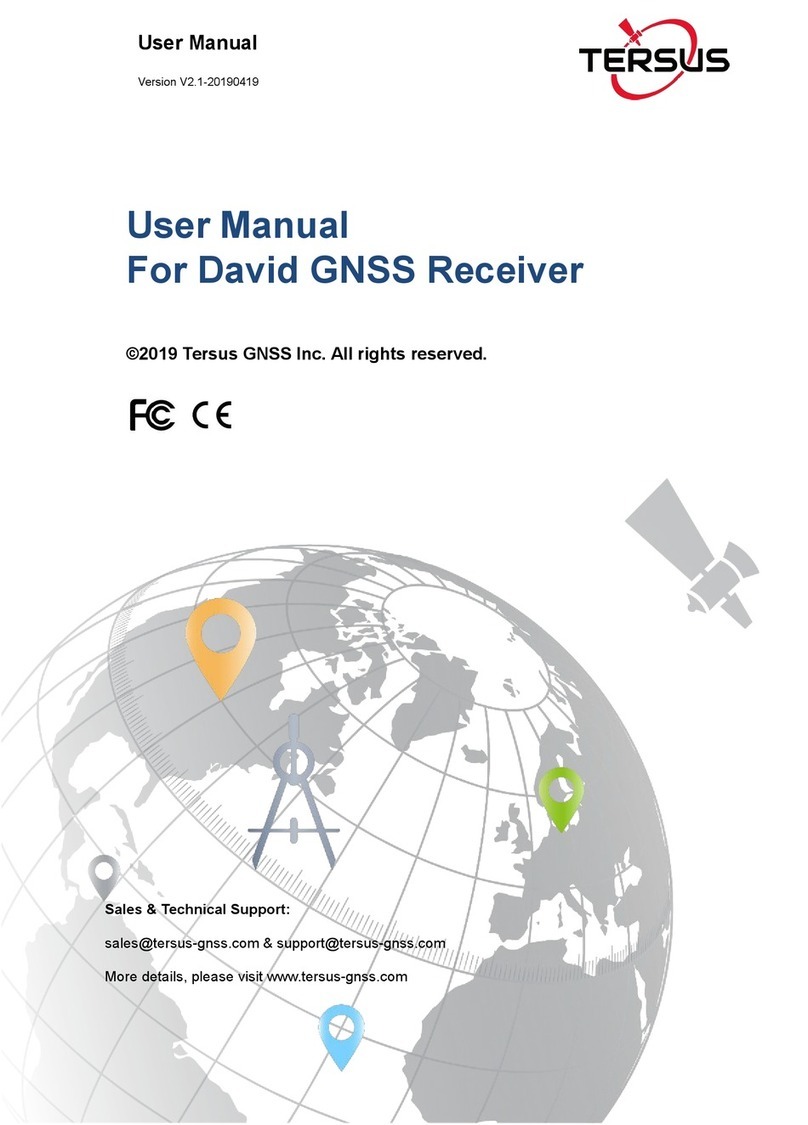
TERSUS
TERSUS David User manual
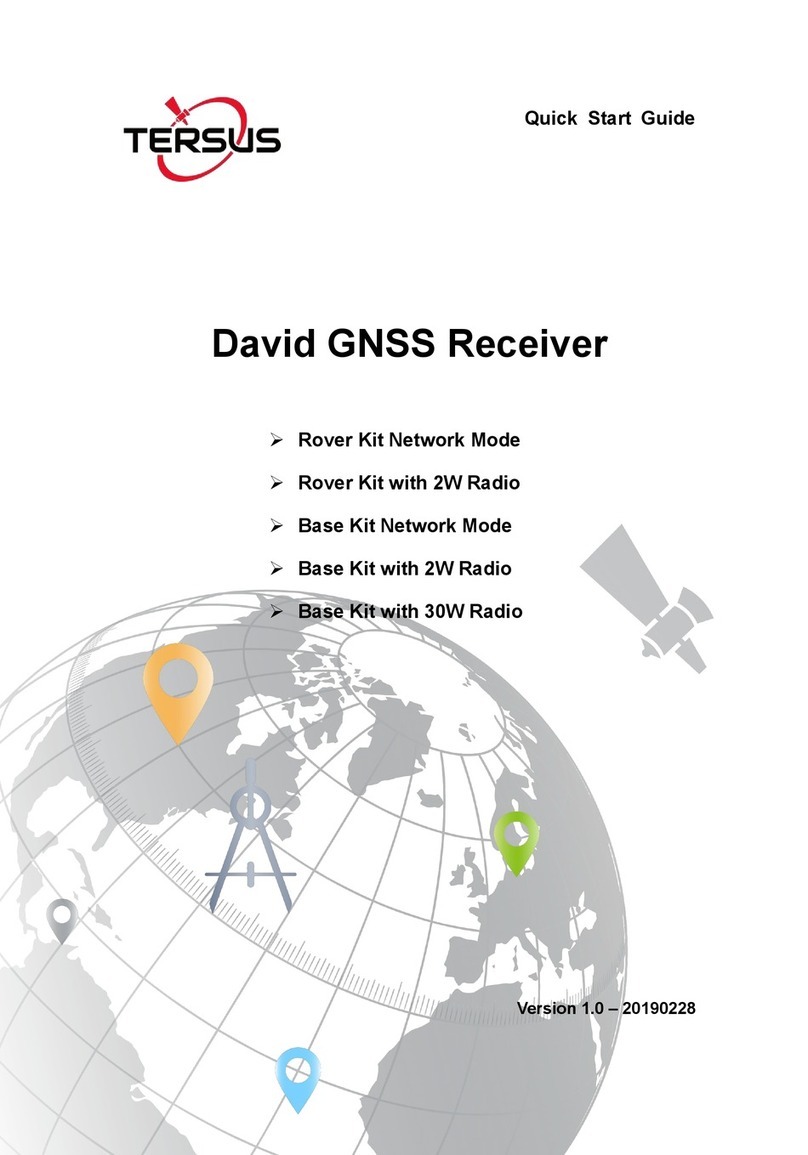
TERSUS
TERSUS David User manual

TERSUS
TERSUS NeoRTK User manual
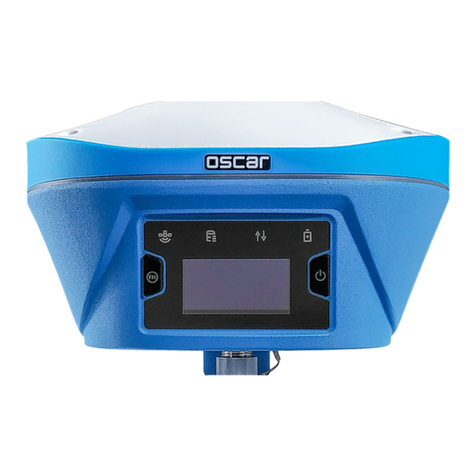
TERSUS
TERSUS Oscars User manual

TERSUS
TERSUS David User manual

TERSUS
TERSUS BX316 User manual
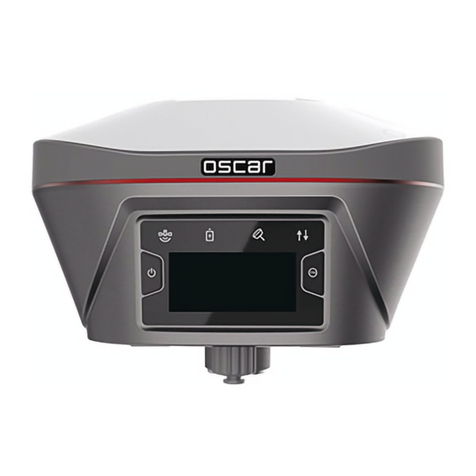
TERSUS
TERSUS Oscar User manual

TERSUS
TERSUS Oscar Quick start guide
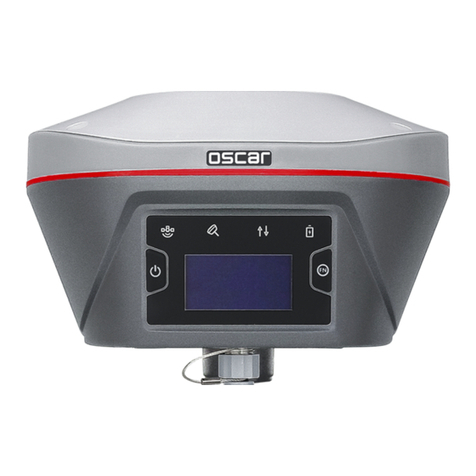
TERSUS
TERSUS Oscar Ultimate User manual

TERSUS
TERSUS David User manual
